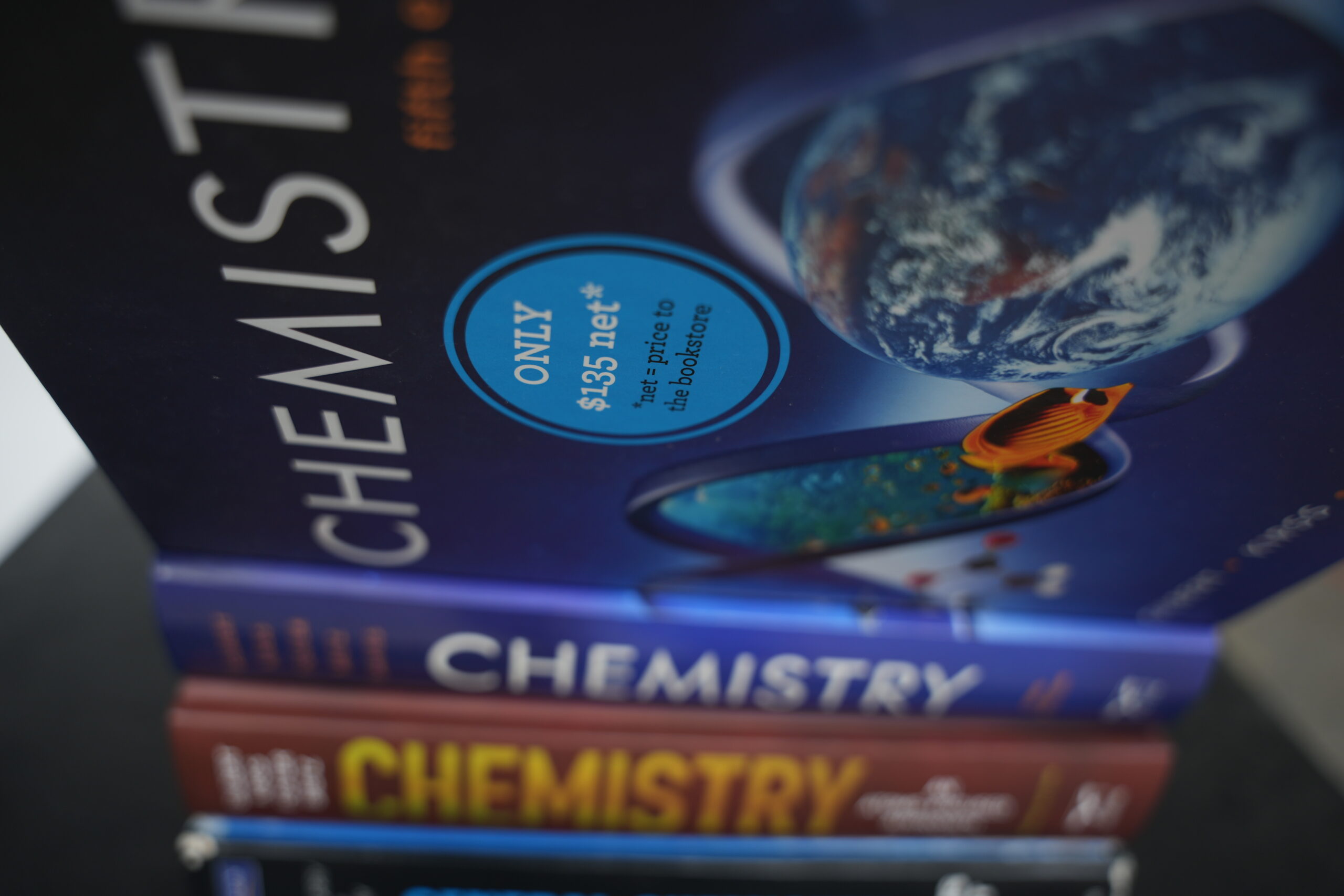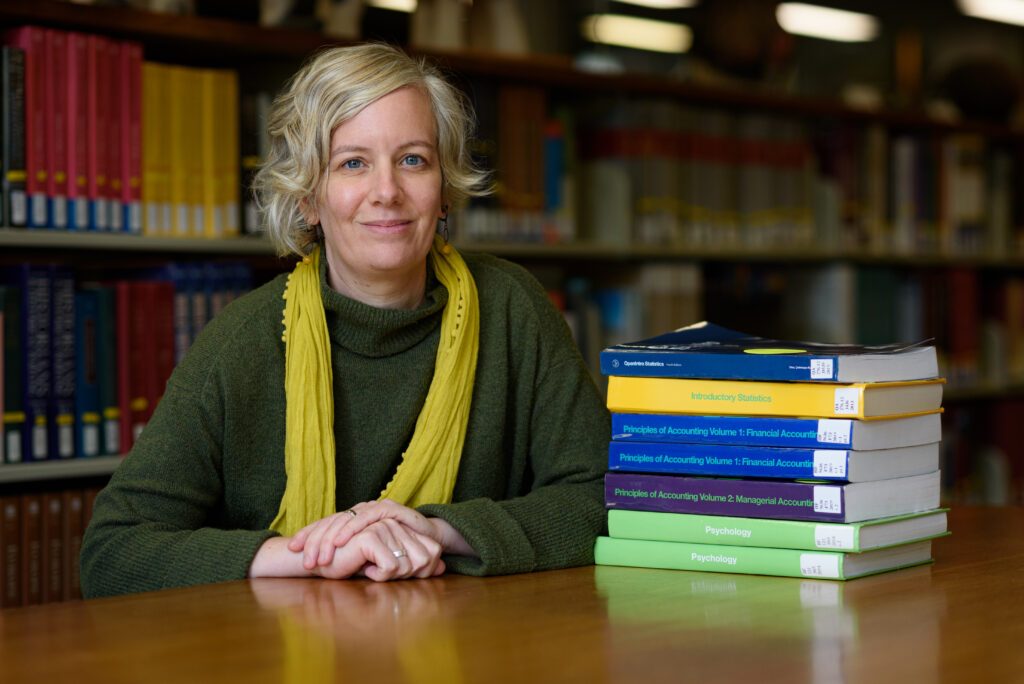
A textbook affordability project called PALSave saves students money and creates a more equitable system for acquiring and using textbooks.
When Karla Fribley ’03 heard about PALSave, a textbook affordability project in Indiana, she thought it was a “nice” concept. When Fribley, Earlham’s instructional technology director and seminaries librarian, dug deeper, she recognized the concept as a chance to promote equity and social justice, and support diversity on the Earlham campus.
“Social justice and equity can seem like such overwhelming concepts, and you often wonder how on earth you can possibly make a difference and change things,” Fribley said. “With PALSave, I realized there was an overlap with textbook access and equity in education, and then I thought, ‘Oh, I can make a difference here.’”
The goal of PALSave, a project of Private Academic Library Network of Indiana, is to encourage faculty at the state’s colleges and universities to build courses using library e-books and other digital textbooks and materials that are available under open license for free.
The project’s goal is to save students money by adopting Open Educational Resources (OER) to reduce costs for students, improve access to required texts and increase student success and retention.
Fribley worked with former Earlham Library director Neal Baker and current director Amy Bryant to invite PALSave administrators to Earlham and do training and spread the word through on-campus teaching circles. Instantly, they found strong faculty support.
“This is one initiative where [teaching faculty] got it right away. It was exciting,” Fribley said. “Upon learning about it, faculty was 100 percent accepting right away.”
She knew that students across the country were burdened with the cost of higher education. Some, especially those from lower socio-economic backgrounds, often needed to take out additional student loans. They skipped meals or worked extra shifts off campus to make ends meet.

“This is one initiative where teaching faculty got it right away. It was exciting.”
Karla Fribley
Others waited until courses began — or until student loans came through — to order books, thus leaving them behind from the start. Or they simply skipped buying books altogether.
“It’s definitely a concern with students [nationwide]. It adds to their stress,” Fribley said. “When I learned about [the issues] I thought ‘Oh my gosh, we have to be doing work in this area.’”
Earlham faculty quickly saw the value of textbook affordability to students whose very existence on campus depended on availability and frugal use of dollars and cents. Her response was fueled by principles she learned while a student at Earlham.
For Fribley, PALSave has become a passion project.
Since the program’s inception, Earlham has become a leading participant in PALSave, according to Amanda Hurford, PALNI’s scholarly communications director and PALSave project lead.
And that, Hurford said, is key, since PALSave is a project delivered to the door of each campus but is dependent upon “campus champions” to give it life and breath.
“Karla has been a champion, and we have been very impressed with Earlham’s involvement,” Hurford said. “They have risen to the top as star adopters of open education resources. That’s what it takes, a grassroots effort. It takes faculty and librarians sharing awareness and expertise about this to effect this change.”
Since the program’s inception in 2019, faculty across all four of Earlham’s academic divisions have participated in PALSave, redesigning classes to find and use textbooks and other materials that students can access at no charge.
Earlham is now second in the state with an average savings of $82.26 per student and third in percentage with 1,134 students enrolled in courses with free textbooks. The 1,134 students is a reflection of the number of students served since the program’s inception. Some students have benefitted more than once.
One of the early proponents was Earlham chemistry professor Lori Watson.
“Textbooks can be hugely expensive, especially science textbooks,” Watson said. “PALNI gave us training and resources that allowed us to put courses using open educational resources together. Access to educational resources should be available to all our students. It’s part of Earlham’s focus on diversity, equity and inclusion.”
Another champion was Earlham biochemistry assistant professor Lexie Kuzmishin Nagy.
“OER supported my pedagogy and reduced the equity gap in my classes,” Kuzmishin Nagy said.
“Rather than use an expensive biochemistry textbook for a single upper-level class, I use various open textbooks to provide students with a foundation before diving into scientific journals to explore a topic.
I did not want money or a financial burden to be a barrier to the study of science, and it is for some students. OER reduced the financial burden of education for my students, while also giving me flexibility in how to approach topics in biochemistry.”
Watson was selected as one of nine educators statewide for PALNI’s PALSave Open Educator Award for 2022, and Kuzmishin Nagy received the same award for 2023.
PALSave is supported by a grant from the Lilly Endowment Inc. and staff and leadership from PALNI, having an impact on 24,000 students across the state since inception in 2019, Hurford said. All 24 of the PALNI-supported colleges, universities and seminaries have instituted the PALSave program.
“I’ve seen champions come to the surface at Earlham,” Hurford said. “Faculty don’t have an impact on college tuition or the food students buy or the rent they pay. But this is one area in which they can impact a student’s life and finances.”
Librarians across Indiana have played a role in expanding PALSave since they often assist in helping faculty find source material for their classes.
“That’s what we’re good at, sifting through options, sifting through complicated websites,” Fribley said. “What’s also exciting is there are lots of ways you can switch to free course mate- rials. Sometimes a library can buy unlimited user e-books that faculty can use that are freely available to everyone in the class.”
José-Ignacio Pareja teaches nutrition science and is a science technology learning specialist and part of the librarian team at Earlham. He redesigned his nutrition science class to have an open resource book for students.
“I knew I wanted to have something that would be accessible to all students,” Pareja said. “The course book I was considering was $160 at the time, and I had 18 to 20 students that year. If you do the math this can become a financial burden to most students.
“My hope is to provide access to all students regardless of backgrounds, where they come from and their needs. Some students have access to lots of resources, others don’t. So to reduce that gap of access is important. You want to think about equity as much as you can.”
Pareja harkened back to his college days in South America when current textbooks, especially in science, were often difficult to come by.
“I would have access to books but only because my professor would travel to the States or Europe for a conference and bring back a book, and we would share it,” he said. “We would literally copy chapters of the book. I did have access, but only because of my professors.”
Beth Mechlin, associate professor of psychology and convener of Earlham’s neuroscience program, used an OER textbook for the first time this fall.
She found two zero-cost textbooks and created her own lecture videos that actually helped her teach her brain and behavior course.
“I found it’s easier to mix and match material to better serve the students and their learning process,” Mechlin said. “In the beginning it’s more work for me, but then in the long run, it’s not. It allows me to give students a wider per- spective and has helped me to think more creatively.”
PALNI asks faculty to have students do an end-of-term evaluation of texts and other class source materials. The response has been hugely positive with more than 90 percent of students responding that they are satisfied with the quality of the course material, Hurford said.
“That’s what we have been hearing from students pretty much across the board,” she said. “They like that they have constant access to material and they are not having to lug around big, heavy textbooks. And pay for them. This program really does have an impact. If we can remove one burden from their scholastic lives, we’re happy to do that.”
Story written by Bill Engle. Photos by Josh Smith.